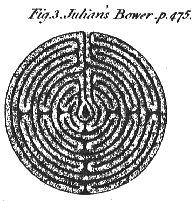
Gentleman’s Magazine, 56, part 1, 474–475 + plate (1786)
{474}
Mr. Urban, May 11.
IF you think the following topographical account of the parish of Aukborough comes within the plan of your correspondent Ximenes (see Mag. for Feb. 1785), and is deserving a place in your Magazine, it is much at your service. Quadratus.
The parish of Aukborough lies in the county of Lincoln, is bounded on the north-east by the lordship of Whitton, on the east by that of Halton, on the south by that of Burton, on the west by the river Trent, and on the north-west by the Humber; it is three miles long from north to south, and two broad, containing near 3000 acres, two thirds of which are grass-land; those parts adjoining the two rivers are exceeding rich and good, the rest are of various kinds, some tolerable, and others very moderate. The arable is also variable; one part is strong wet clay, another red dry clay, and a third light red sand; the rent is from 10s. to 20s. per acre. Part of the parish has been inclosed a long time, as is evident from a great number of large ash-trees in the hedge-rows, some of which have stood above a century; the other part was inclosed in the years 1765 and 1766, which contained near 2000 acres. The principal proprietors are: Thomas Goulton of Mount St. John, esq. lord of the manor, Mr. Jonathan Dent, Mrs. Ingram, Mr. Watson, Mr. Edward Smith, Mr. John Dudding, Mr. Samuel Huterson, and Mr. Thomas Anderson. The old inclosure, called Walcot-closes, on the west side of the road from Aukborough to Burton, is held by lease under the dean and chapter of the cathedral church of Peterborough, by Thomas Goulton, esq. Here is an estate of 40l. a year belonging to Magdalen College, Cambridge, the gift of a Countess of War- {475} wick. The living is worth 40l. a year, in the gift of Tho. Goulton, esq. Here are two villages in the parish, Aukborough and Walcot; the former is situated on the summit of a steep cliff (which runs through the parish in a north and south direction, steep to the west, and plain and level to the east), opposite the influx of the rivers Trent and Ouse into the Humber; it contains about 250 inhabitants, has a neat stone church with a square tower; the choir was re-built in the year 1771 by Christopher Goulton, esq. who lies interred there, and a neat marble monument is erected to his memory by his son, the beforementioned Tho. Goulton, esq.
A branch of the Roman road, called Hermen-street, comes from Winteringham to Aukborough, and at the south end of the village is the Roman camp, now called Countess Close, it is square, 310 feet on each side; the ditch and rampart are very perfect on three sides; the west is terminated by the cliff; the rampart is 15 feet high from the bottom of the ditch, which is dry, and 27 feet wide. Dr. Stukeley, in his “Itinerarium Curiosum,” says, there are no marks of buildings in the camp; but there certainly are evident traces of foundations: the Dr. likewise says, he was informed that coins have been found in great numbers; I never heard of any, and am pretty certain none have been found of 20 years. The camp commands a beautiful and extensive prospect of the rivers Humber, Trent, and Ouse, the west of Yorkshire to the distance of 40 miles, the isle of Axholme, and part of Nottinghamshire. A view so extensive, and so beautifully intermixed with windings of rivers, towns, villages, woods, and distant hills, is scarce to be met with in this, or any other county. In a plot called the Green (adjoining the camp on the north) is the Julian’s Bower; it is a circular work, cut in paths wide enough for a person to walk upon, in the form of a labyrinth or maze; it is 42 feet in diameter, and the paths, to the center and back again, measure 430 yards; I have inclosed a drawing of the bower (see plate II. fig. 3.). Walcot is half-a-mile south of Aukborough; here is a small seat, the temporary residence of Thomas Goulton, esq. which, with a farm-house and four cottages, make up the villa. Not far south of Walcot, on the side of the cliff, is a fine spring, called Kell-well; in the stream flowing from it are found great numbers of star-stones; and, in most parts of the parish, fossil-shells of different sorts are plentiful.

Your correspondent R. D. (see vol. LV p. 59) is mistaken in the person’s name who visited Lynd holm-house; it was Geo. Stovin, esq. not Stovius.
Q.